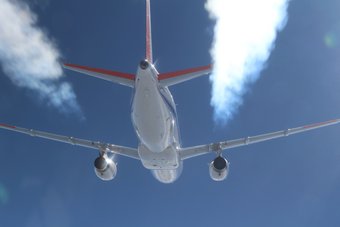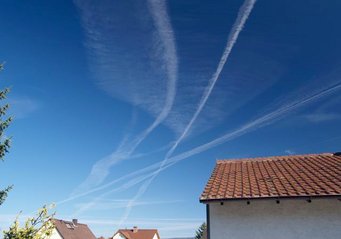Significantly lower climate impact of contrails when using sustainable fuels
Results of flight tests by DLR and NASA: Sustainable fuels reduce the number of ice crystals in contrails and thus their climate impact.
Press release of the DLR / with additions of the Max Planck Institute for Chemistry
The warming effect from contrails represents the largest contributor to the climate impact of air transport, having an even greater effect than carbon dioxide. Now, researchers at the German Aerospace Center (Deutsches Zentrum für Luft- und Raumfahrt; DLR), working together with the US National Aeronautics and Space Administration (NASA) and MPIC, have found that the climate impact of contrails can be reduced. Using a 50-50 blend of kerosene and Sustainable Aviation Fuel (SAF), they achieved a halving of the number of ice crystals in contrails under actual flight conditions. This results in a 20 to 30 percent reduction in the climate impact of contrails. The research team reports its findings in the current issue of the Nature Research journal Communications Earth & Environment. The results pave the way to noticeably reducing the climate impact of aviation in the short term.

"During the joint flight tests conducted by DLR and NASA in 2018, we were able to clearly demonstrate that the use of sustainable fuels gives rise to fewer soot particles in engine exhaust gases and that this, in turn, results in fewer ice crystals in condensation trails. However, on average, the ice crystals are slightly larger," explains Christiane Voigt of the DLR Institute of Atmospheric Physics in Oberpfaffenhofen. "This evidence is a breakthrough for the possibilities of climate-friendly air transport. A smaller number of ice crystals reduces the energy input into the atmosphere caused by contrails. This significantly reduces the climate-warming effect of contrail cirrus."
Flight in an exhaust plume
The flight tests took off from Ramstein Air Base in Rhineland-Palatinate during 2018. The DLR ATRA research aircraft, an Airbus A320, flew over Germany several times using different fuel blends. These included pure Jet A-1 kerosene as a reference, as well as 70-30 and 50-50 blends of kerosene and the sustainable biofuel HEFA (Hydroprocessed Esters and Fatty Acids). NASA's DC-8 research aircraft followed the A320 with a delay of one to two minutes to collect data on its emissions and contrails using numerous measurement instruments, some of which were installed by NASA and DLR. The joint research campaign took place under the name ND-MAX/ECLIF 2 (NASA/DLR-Multidisciplinary Airborne eXperiments/Emission and CLimate Impact of alternative Fuel) together with partners from FAA, NRC, Aerodyne, Missouri S&T, Boeing, the Max Planck Institute for Chemistry and the Universities of Mainz, Innsbruck and Oslo.

The research team from Mainz used their globally unique spectrometer for aerosol particles, ERICA (ERc Instument for the Chemical composition of Aerosols). "With the help of ERICA, we were able to study the chemical composition of individual particles, both in the exhaust gases themselves and in the interior of the ice crystals that form the contrails," explains Stephan Borrmann, director at the Max Planck Institute for Chemistry, who is also a professor at the Institute of Atmospheric Physics of the Johannes Gutenberg University. His team is currently evaluating the data and plans to publish it soon.
"In our work, we look at more than just individual technologies – always at aircraft and air transport as an overall system. This gives DLR systems-level expertise in aeronautics," emphasises Anke Kaysser-Pyzalla, Chair of the DLR Executive Board. "We see ourselves acting in the role of an architect for aeronautics research – from fundamental investigations to applications, in close coordination and cooperation with international research partners, the aircraft sector and industry. In this way, we are making our contribution to the Green Deal in the air transport sector."
Sustainable aviation fuels
Sustainable fuels are obtained from renewable sources without using petroleum-based hydrocarbons and have a lower carbon footprint than fossil kerosene. Fuels based on plants or waste are conceivable here, but also, in the near future, e-fuels synthesised using renewable energy sources and sustainably obtained 'green' hydrogen. "What all these sustainable fuels have in common is that they can be produced without cyclic hydrocarbons, referred to as 'aromatics'," explains Patrick Le Clercq, ECLIF project manager at the DLR Institute of Combustion Technology in Stuttgart. "Fewer aromatics in the fuel means less soot in the emissions and therefore fewer ice crystals in the contrails. Thus, sustainable fuels reduce the two biggest climate-warming effects of air transport – contrails and the carbon footprint."
Soot, ice crystals, contrails
Aircraft engines emit soot particles. These act as condensation nuclei for small, supercooled water droplets, which immediately freeze to form ice crystals and become visible as contrails in the sky. The ice crystals in the contrails can persist for several hours in cold, humid conditions at altitudes of approximately eight to 12 kilometres, forming high clouds referred to as contrail cirrus. These clouds can have a localised warming or cooling effect, depending on the position of the Sun and the nature of the underlying surface. Research has shown that the warming effect predominates globally. The occurrence of these clouds is extremely variable in time and space, so that a few contrail hotspots are responsible for a large part of the warming effect.
Contrails and the resulting contrail cirrus clouds only remain in the sky for a few hours. Once the number of ice crystals is reduced, their warming effect is promptly dissipated. This makes the targeted use of sustainable fuels on flight routes with frequent contrail formation particularly attractive for achieving a rapid effect for climate protection. Avoiding in addition carbon dioxide emissions from fossil fuels brings important long-term benefits, because carbon dioxide remains in the atmosphere for more than 100 years and drives global warming.
"With Sustainable Aviation Fuels (SAFs), we have a bridging technology on the way to emission-free air transport," explains Markus Fischer, Deputy Board Member Aeronautics. "In the joint flights with NASA and their evaluation, we have contributed DLR's scientific and technical expertise in the field of alternative fuels, combustion technologies and the climate impact of air transport. This has been done in close partnership with industry."
Next step – flying with 100 percent sustainable fuel
Following the promising results achieved using 50-50 blends of kerosene and sustainable fuel, researchers are now looking forward to examining how flights with pure SAF will affect emissions and contrails. To this end, joint flight tests were recently conducted by Airbus, Rolls-Royce, DLR and other partners. As part of the ECLIF3 project, an Airbus A350-900 flew using only the sustainable aviation fuel HEFA and was followed by DLR's Falcon 20-E research aircraft. Data from the flights is currently being analyzed. Further test flights are planned for autumn 2021.

